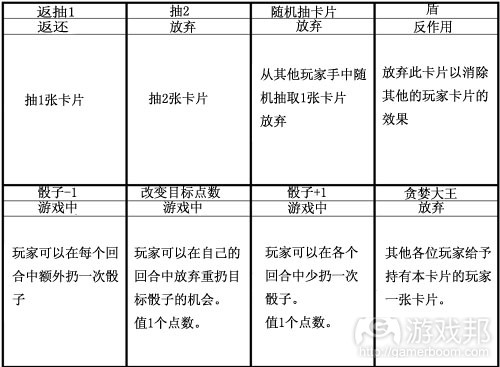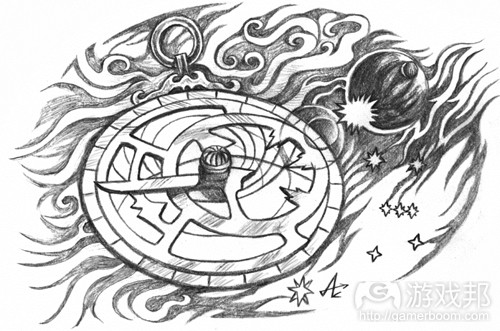分享制作骰子机制RPG纸牌游戏的过程(上)
作者:Michael the OnlineDM
在本文中,我将与大家分享我从设计到制作到最终售出一款游戏的经历。这是一款用卡片和骰子玩的游戏——《Chaos & Alchemy》。(请点击此处查看本文下部分内容)
灵感
事情要从今年的5月31日说起。下班后,我一边听游戏广播(经常的事),一边开车回家。我突然听到Jennisodes播客的老片段,其中,是一个游戏设计小组的会议录音,Fred Hicks 提到一些关于游戏的事,他说可以用新的骰子机制(他只是说新的骰子机制可让游戏有趣,也许他有一个文件全是关于骰子机制的)制作游戏。
不知道为什么,这段话启发了我的思考。我最初打算做一个带骰子机制的角色扮演游戏。这个骰子机制就是转动两个六面骰子,两个都要达到或超过一个目标点数。如果两枚骰子都达到目标点数,那么玩家就完全胜利;如果都低于目标点数,那就是彻底失败;如果一个超过一个低于目标点数,那就是平局。此时我在考虑平局的计数,但我还不确定。
看这游戏有些发展潜力,但很快,我感觉这种机制对一款角色扮演游戏来说并不是那么有趣(如果有人真用这个机制做成一款角色扮演游戏,我倒希望听听!),也许更像桌面游戏一点可能就行得通了。
目标点数是什么?我希望在整个游戏过程中不断改变目标点数,在桌面中间有一个共用的骰子,那“目标骰子”,玩家要达到或超过目标骰子给出的点数。这款游戏用卡片来玩,达到目标点数的玩家可以抽卡片或出卡片,而当点数低于目标点数时,玩家会被淘汰。点数为偶数的玩家可以再扔一次目标骰子。
首个原型
太好了,有进展了!到家后,我一边做饭一边仔细考虑这个游戏。之后我着手制作了一些卡片。因为我工作时一直用Excel,所以决定先用它做几张卡片模板。第一个单元格写的是卡片名称,下一个单元格提示告诉玩家出卡片后用卡片做什么,第三个单元格写的是卡片的规则。我将单元格分开一点,最后一页表格带有12张卡片——三行四列,每列1张卡片。
因为是星期四,我晚上要打排球,所以我就去打球权当休息了。回家后,我又做成了一些卡片(这样就凑齐32张了),各张卡片复印4张,用裁纸刀分好,之后和魔法卡片一起装进套子里(我几年前得到一些完整的魔法卡片,背面都是一样的)。
我叫妻子跟我一起试玩。我们在大桌子上洗牌,分成两份玩。当时游戏的目标点数是10点,且手中的每张卡片各算作1点。卡片的名称有如“抽2张”、“随机”和“改变目标点数”等。这个游戏没有其他修饰的东西——只有机制。
但是,游戏很有趣。出人意料地有趣!
我从无到有地发明了一款游戏,且我和妻子都觉得玩法挺有趣。我想这游戏值得继续改进。
外部测试
两天以后,我和几个熟人因测试《龙与地下城》而聚在一起。因为还有一个玩家还没来,所以我们尚有些许空闲时间,我就拿出我复印好的卡片和他们玩起来。
其中一个玩家完全搞明白了,另一个则相当困惑,但还坚持玩着。这已经给我足够的理由完善这个游戏了。但我知道我必须给游戏一个真正的主题,而不单单只是游戏机制。我的妻子已经建议我加上一点有幻想色彩的东西,而我自己又很喜欢炼金术的题材。
增加游戏主题
星期天,我花了相当长的时间变更卡片的通用名称,如把“抽2张卡片”和“再扔一次骰子”变成“Quick Study” 和“Oversized Cauldron”。我还改变了卡片的属性,如把“游戏中”改成“实验中”。这样,一个主题就要成形了!
对话专业人士
我很幸运有一个好朋友已经从事桌面游戏、卡片游戏和电脑游戏的专业设计好多年了。6月3日,星期天晚上,我和另一个朋友聚到他的地方,测试我那款连名字都还没有的游戏。我没有料到我们居然连续玩了三个小时。
这真是最棒的实际测试。我们按照游戏最初设计出来的样子进行测试,然后探讨得失。起初游戏规定玩家要做三件事:抽一张卡片、出一张卡片和进行实验(扔一对骰子)。其中,扔骰子的结果是再抽出一张卡片或淘汰卡片或二者皆有。我们决定每个回合只有一个抽或出卡片的机会,还再增加了一个骰子(这样就要扔三个骰子了)。调整后的游戏,目标点数(现在定名为“幸运点数”)比扔两个骰子时更可能发生改变,因为扔三个骰子时出现偶数的可能性更大了。
我们开始集中精神思考游戏中有趣的地方和无聊的地方。此时,玩家赢得游戏的主要方法是获得10点,也就是手中持有一堆卡片——每张卡片值1点。这太无聊了了;用表格玩还不错,但只是凑一堆卡片就比较无趣了。这个要在绘图板改一下。
另一个问题是大多数时候游戏结束得太突然,太随机了。比如,玩家的对手可能只通过一个幸运回合就将点数从5点积累到10点了。我开始测试“如果一名玩家在他或她的回合中达到10点或以上,其他玩家各获得一个回合然后结束游戏。”这条规则的问题在于,对第一个达到10点的玩家来说太糟了,因为其他玩家都占到便宜了。
那天晚上,我带着一大堆笔记和有用的建议回家继续工作。改变点数机制很容易,也就是将持有的卡片点数为10作为主要获胜条件变成持有的卡片点数为0。许多之前出的卡片都有各自的效果,然后放入淘汰卡片堆里成为进入室验室的卡片,这些卡片进入实验室后也有其效果,此后一直放在实验室里,它们值1点或2点。
远程测试
发明游戏后的第一个晚上,我发了一份带卡片和规则的文件给我远在宾夕法尼亚的兄弟;星期一早上我又给他发了更新版本,这样他就有了改良后的卡片和主题等。令人惊喜的是,他说他已经和未婚妻及其他朋友一起玩了那个只有机制的版本,他们都很喜欢那个游戏!在他的邮件里满是试玩后的反馈。这款游戏变得更好了。
我还让其他地方的朋友测试了我的游戏,这为《Chaos & Alchemy》其他方面的改进起到了很大帮助。(本文为游戏邦/gamerboom.com编译,拒绝任何不保留版权的转载,如需转载请联系:游戏邦)
Inspiration and first prototype
by Michael the OnlineDM
Welcome to my new blog series – Making the Game. In this series, I’ll talk all about the process I’ve gone through (and am still going through) of creating a game and ultimately producing and selling it. In this particular case, I’m talking about my upcoming card and dice game – Chaos & Alchemy.
Chaos and Alchemy logo – by Bree Heiss
Inception
It all started on May 31, 2012. I was driving home from work, listening to gaming podcasts (as I often do), and I happened to be listening to an old episode of Jennisodes. In this episode, Jenn had recorded a panel of game designers at a conference, and Fred Hicks mentioned something about a game possibly being based around an innovative dice mechanic (nothing specific – he was just saying that an innovative dice mechanic is something that can make a game interesting, and that he might have a file with nothing but dice mechanics).
I don’t know why, but this comment got me thinking. I originally was thinking about role-playing game dice mechanics here, and I thought of a mechanic where checks are resolved by rolling two six-sided dice, each trying to meet or beat a target number. If they’re both over the target number, you have total success. If they’re both under, it’s total failure. If one is over and one is under, it’s a partial success. I was thinking that a tie counted toward success at this point, but I wasn’t sure.
This seemed like it had some potential, but I soon decided that it wasn’t all that interesting for a role-playing game (although if anyone builds a role-playing game around this mechanic, I’d love to hear about it!). Something more like a board game, though, might work.
What would the target number be? I liked the idea of having it change throughout the course of the game, and having a shared die in the middle of the table that people are trying to meet or beat. This would be the “target die”. The game could work with cards, and beating the target die would let you draw cards or play cards while rolling under the target die would make you discard. Rolling doubles would make you re-roll the target die.
First prototype
Yeah, this was going somewhere! When I got home from work, I mulled this over as I cooked dinner for my wife, then decided to start making up some cards. Since I use Excel all the time at work, I decided to make up a little card template in Excel. One cell would hold the card name, the next cell would tell what you do with the card after you play it, and the third cell would have the rules text for the card. I messed around with the spacing a little bit and ended up with twelve cards to a page – four cards in each of three rows.
Actual examples of some of my initial playtest cards
Since this was a Thursday, which was my volleyball night at the time, I took a break for a while to go play volleyball. When I came back home, I finished putting together a few more cards (32 cards total), printed out 4 copies of each card, cut them up with my paper cutter and dropped them into sleeves with Magic cards (I just grabbed a few completed Magic decks from years ago that all had the same backs).
I talked my wife into trying the game out with me. We shuffled the giant deck of cards, drew two cards each, and started playing. At this point in time, the goal of the game was to get to 10 points, and each card in your hand counted for a point. The cards had names like “Draw Two”, “Take Random” and “Change Target”. There was no flavor at all – just mechanics.
And it was fun. Surprisingly fun!
I had just created a game from nothing, and it was actually fun for me and my wife to play. I decided it was worth continuing to develop it.
Next steps
From that point, development on my game continued, and I plan to talk more about this in future blog posts.
I want to ask at this point: Is this interesting stuff for my readers? I’m still playing D&D and will continue to write about it, but a lot of my free time is going to Chaos & Alchemy right now, so I’d love to share it if you’re interested.
Outside playtesting and adding a theme
Welcome back to my blog series Making the Game, in which I talk about the process of creating my card and dice game called Chaos & Alchemy! In Part 1, I discussed the inception of the idea for my game and the first prototype I built and played with my wife.
Two days after the inception of my game, I found myself getting together with some acquaintances for a public playtest of D&D Next, which had just become available for testing about a week earlier. We had a little time to kill before one of our players would be showing up, so I broke out the cards that I had printed up and tried the game with them.
One of the guys totally got it. The other was pretty confused, but soldiered on. It was encouraging enough for me to feel like I should keep working on the game, but I knew that I needed it to have an actual theme rather than raw mechanics. My wife had already suggested something fantasy-ish, and I liked the idea of alchemy for some reason.
I spent a fair amount of time on Sunday, June 3, changing the generic names of cards like “Draw 2″ and “Roll Extra” into things like “Quick Study” and “Oversized Cauldron”. I changed the references of cards being “in play” to being “in your laboratory”. A theme was taking shape!
Talk to the pros
I’m lucky to have a good friend who has worked for many years as a professional game designer on board games, card games and computer games, and I got together at his place with him and another friend of ours Sunday evening, June 3, to playtest the heck out of my still-nameless game. I didn’t realize that these guys would be up for three hours of solid playtesting, but that’s exactly what we did.
This was real playtesting at its best. We tried the game as I’d originally designed it, then talked about what was working and what wasn’t. In the initial rules, players had three things to do each turn: draw a card, play a card, and run an experiment (rolling a pair of dice) which could result in extra card draws and plays or in some forced discards (or a mixture). We started toying with this, going to a single draw/play option each turn and adding an extra die to the experiment (now rolling three dice instead of two). This changed things dramatically, making it much more likely that the target die (now renamed the Fortune Die) would change with people rolling doubles since doubles come up a lot more with three dice than with two.
We started focusing on what was fun in the game and what wasn’t. At this point, the main way you could win the game would be to get to 10 points by holding a bunch of cards in your hand – each card in hand was worth a point. This was rather unfun; playing cards to the table was cool and exciting, but just hanging on to a bunch of cards felt kind of lame in comparison. This was a change that would have to be handled at the drawing board rather than at the table, though.
Another issue that caused problems was that the game ended rather suddenly and randomly a lot of the time. If your opponent goes from 5 points to 10 points via a lucky turn, well, that’s it. I started experimenting with rules that said, “If one player ends his or her turn with 10 or more points, each other player gets one turn and then the game ends.” This had the problem of making it BAD to be the first to 10, since everyone else would dump on you. Tricky.
I left that evening with tons of notes and useful feedback, and I got to work. Changing the point mechanism from cards in hand being the main victory condition to cards in hand being worth nothing was surprisingly easy. Lots of cards that previously were played, had their effect and then went to the discard pile became cards that came into your laboratory, had an effect when they came into the lab, and then sat there for the rest of the game being worth a point or two.
Long-distance playtesting
I had sent a file with the cards and rules to my brother in Pennsylvania (I’m in Colorado) after the first night of inventing the game, and I sent him an update the following Monday morning to give him the improved cards with a theme and everything. Imagine my surprise when he said that he had already tried out the mechanics-only version of the game with his fiancee and another friend, and that they liked it! More awesome playtest feedback filled his email, and the game kept getting better.
Having people in other parts of the country playtesting my game would prove to be a constant, useful tool throughout the rest of Chaos & Alchemy’s development.
More to come…
I’ll wrap up this installment of Making of the Game here, with another request for feedback: Is this stuff interesting to my readers? I know that I personally would have enjoyed reading about other peoples’ experiences with game creation when I was getting started, but I might be the only one!(source:onlinedungeonmaster part1,part 2)










































 闽公网安备35020302001549号
闽公网安备35020302001549号